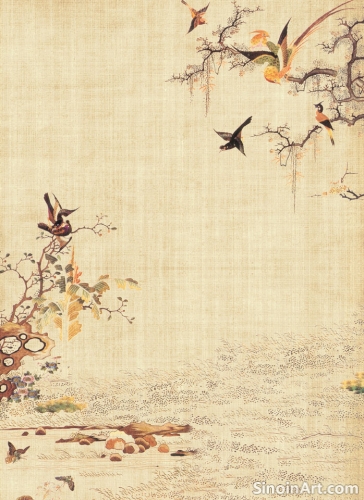The Use of Borders and Mountings in Gongbi Painting
|
The borders and mountings surrounding a Gongbi painting are not merely decorative elements; they are an integral part of the artwork, framing the image, providing visual balance, and enhancing the overall viewing experience. The thoughtful use of borders and mountings is critical to the overall presentation of the piece.  The style and color of the borders and mountings are carefully chosen to complement the painting itself, creating a sense of visual harmony. These elements are used to guide the viewer's eye and create a sense of balance and wholeness. The border and mounting should never detract from the artwork, but should instead enhance its overall impact.  The use of specific materials in the borders and mountings, such as silk, brocade, or paper, also contributes to the overall aesthetic and cultural significance of the artwork. The chosen materials also reflect the intended cultural context of the painting.  The borders and mountings can also be used to separate the painting from the external world, allowing the viewer to focus on the artwork itself. The careful framing creates a space that is set apart from the space surrounding it. The use of mounting helps to create this space for the viewer. The dimensions of the borders and mountings are also carefully considered to provide an appropriate amount of space around the painting, enhancing its visual impact and creating a sense of balance. The relationship between the artwork and its frame are a key component of the overall design. The careful attention to the details of borders and mountings in Gongbi painting reflects the Chinese artistic sensibility that sees every aspect of the artwork as contributing to the overall whole. The design of the frame and mounting is as important as the design within the painting itself. |
Tag : Art framing, Gongbi mounting, painting borders, art display, visual balance
Related information
- The Spiritual Aspects of Gongbi Painting
- The Legacy of Gongbi: Ancient Roots and Modern Blossoming
- Gongbi Painting and the Depiction of Clouds and Mist
- The Enduring Legacy of Gongbi Painting: Tradition and Innovation
- The Cultural Significance of Gongbi: More Than Just Art
An examination of the spiritual dimensions of Gongbi painting, highlighting its meditative qualities and connection to nature.
This article explores the history and legacy of Gongbi painting, from its origins in the Tang Dynasty to its evolution through the Song and subsequent dynasties, and its current resurgence in contemporary art.
This article explores the depiction of clouds and mist in Gongbi painting, highlighting the techniques used to create a sense of depth, luminosity, and atmosphere, and how the subtle variations in color and tone evoke a sense of mystery and serenity.
Gongbi painting, rooted in the rich artistic traditions of imperial China, has proven to be an enduring and highly versatile art form, adapting and evolving across generations while maintaining its core principles of precision, detail, and symbolic depth. The long history of Gongbi painting continues to be influential on modern art and the appreciation of traditional techniques.
This article explores the cultural significance of Gongbi painting, highlighting its connection to Chinese values, aesthetics, history, philosophy, and its role in preserving cultural heritage.